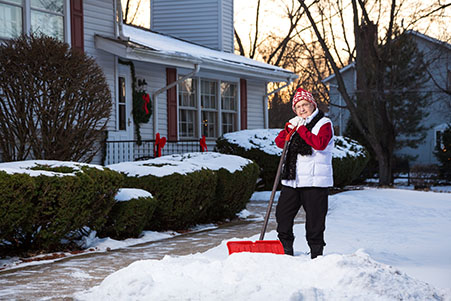We’re already into cold weather season, but it’s never too late to ensure that your house is protected in winter temperatures. We’ve pulled together some helpful tips to help you prepare for freezes, snowstorms, or other adverse conditions.
Prepare the Inside of Your Home
Getting your home ready indoors for colder temperatures will not only keep you and your family more comfortable this winter, but also help prevent expensive, inconvenient repairs.
- Get your HVAC system ready
It’s wise to have your heating and cooling system inspected by a professional twice a year – in the fall and in the spring – to keep everything running smoothly. Many HVAC service companies will put you on a biannual service program, so you don’t have to worry about remembering.
At the very least, ensure you change your system’s filters regularly to keep it running efficiently and safely. There are several websites that offer a subscription service for filters so you can save a trip to the store and always have one ready to go.
- Seal your windows and doors
Don’t waste the effort of tuning up your HVAC system just to let frigid air seep in around your windows and doors. The U.S. Department of Energy estimates that heat gain and heat loss through windows are to blame for 25-30% of residential cooling and heating energy use.
Your windows and doors need to be properly sealed to reduce heat loss. You can take care of it yourself with caulk – pro handyman Bob Vila has some tips to help you do it right – or you can hire a professional.
- Clean out your chimney and fireplace
Soot and ash from previous seasons can clog your fireplace and chimney, and create dangerous conditions that could cause a fire. Protect your family and your home by purchasing a chimney cleaning kit, or hiring a professional chimney sweep, which costs an average of $252.
There are many more areas of your home to check and maintain to prevent fires. Don’t forget to test your smoke detectors monthly – or at least every time you change your clocks to or from Daylight Saving Time.
- Take care of your pipes
Cover any pipes that are in danger of freezing, such as those closest to your outside walls, with pipe insulation to help prevent them from bursting.
When temperatures drop drastically you can also run a slight trickle of water in each of your faucets to keep water moving and lower the chances of the pipes freezing. This is an especially important trick to remember if you lose power and heat, which increases your chances of frozen pipes.
Protect the Outside of Your Home
Don’t forget about important winter prep for the outside of your house. Taking care of your to-do items now will save you time outside in frigid temperatures later.
- Maintain your walkways and driveway
Snow and ice can cover trouble spots, creating a tripping hazard or causing damage to your vehicle. Take a look today to see if you need any flatwork repairs so you’re not kicking yourself later.
You also might want to check out your snow shovel – do you need a new one before the first snowflakes fall and the hardware stores sell out? Planning ahead now will save you frustration later. It’s important to keep your walkways clear of snow and ice so no one slips and gets hurt.- Trim your trees
Carefully check the trees around your home and look for any branches that could potentially break off in strong winter winds or an ice storm. The last thing you want to deal with in freezing temperatures is a hole in your roof or a smashed car caused by a fallen branch – or even worse, an entire tree.
- Detach your hoses and cover your outdoor faucets
Even more than your indoor pipes, your outdoor faucets and pipes are vulnerable to the colder temperatures. Leaving an undrained hose attached to your home can freeze a faucet and pipe faster than you think, potentially leading to flooding inside.
The American Red Cross recommends detaching and storing your hoses away for the winter. For even more protection, you can purchase inexpensive outdoor faucet covers at any hardware store to keep faucets insulated.
- Shut down your sprinkler system if you have one
Freezing temperatures are no friend to in-ground sprinkler systems either. Prevent long-term damage and short-term headaches by properly shutting your system down for the season.
Bob Vila has tips for winterizing your sprinkler system yourself, but he and his team strongly recommend hiring a professional to be sure the job is done right.
- Store or cover your patio furniture
Create an Emergency Kit Just in Case
Finally, it’s always a good idea to have an emergency pack ready in case you do lose power. For the winter months, that kit might include:
- Firewood
- Flashlights (with fresh batteries) and lanterns
- Candles and lighters/matches
- Battery-operated radio
- Portable charger for your cell phones and other devices (pre-charged, of course)
Don’t forget shelf-stable and/or ready-to-eat food, water, blankets, warm clothing, and anything else you might need to stay cozy and comfortable.
Take the Time Today To Get Ready for Winter
When it comes to protecting your home from winter weather damage, proactive planning is always the best strategy. Taking the steps we’ve outlined will help make sure you’re staying warm and enjoying time with your family this winter – instead of dealing with a disaster.
CONTACT A LOAN EXPERT

